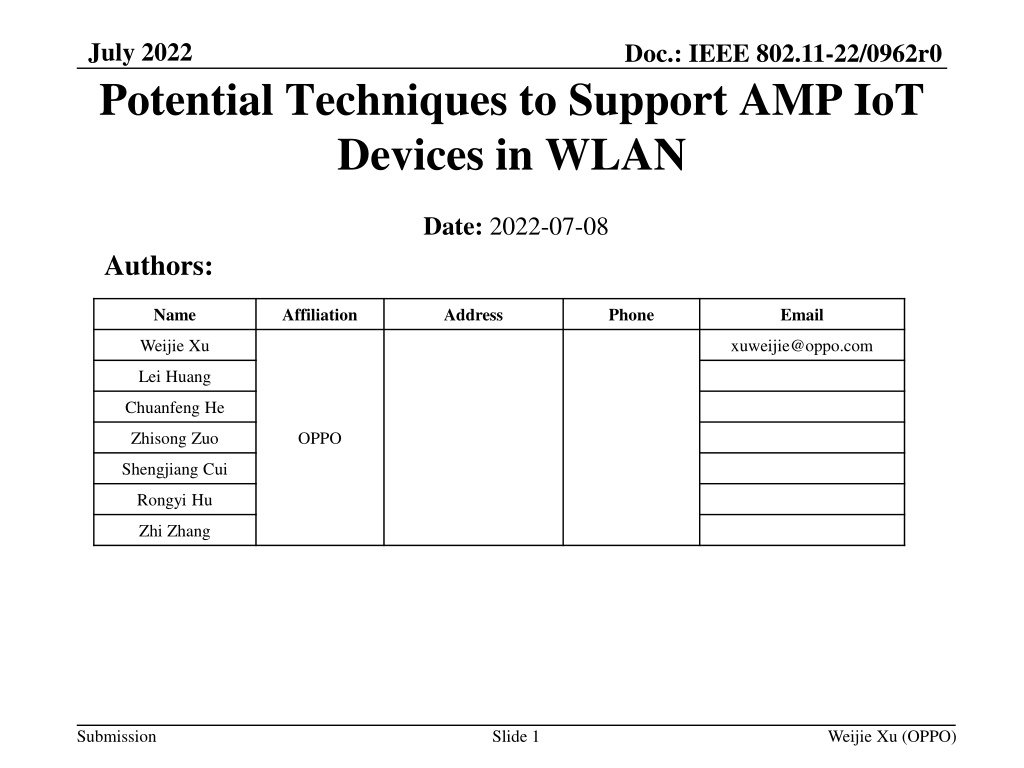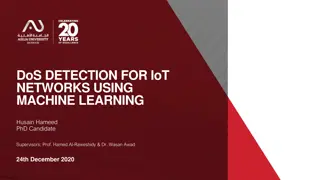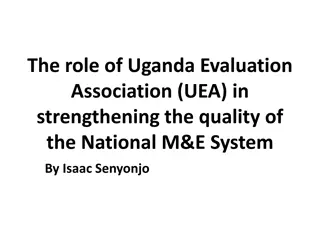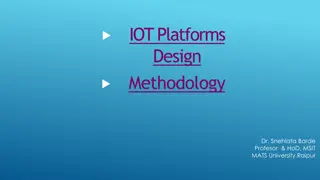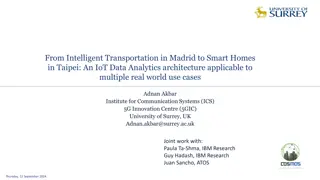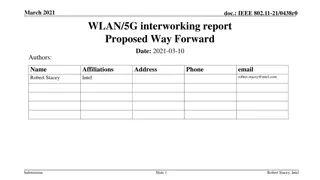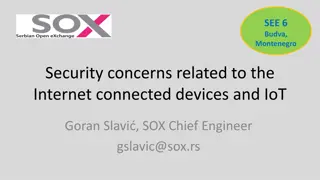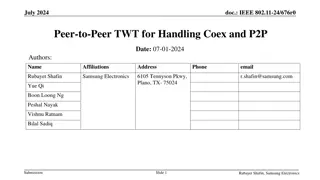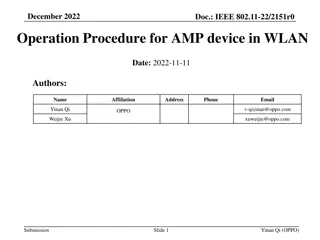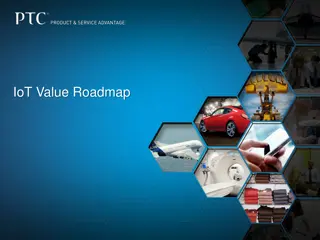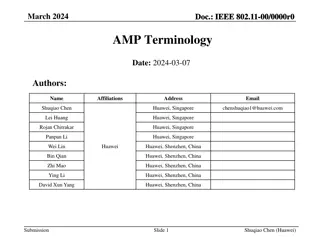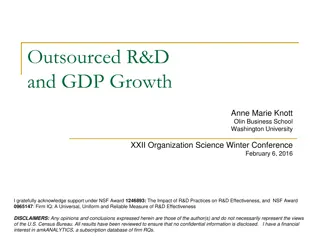Supporting AMP IoT Devices in WLAN
Potential techniques for supporting AMP IoT devices in WLAN involve addressing challenges such as ultra-low complexity, power consumption, and compatibility with existing Wi-Fi systems. The document outlines device types, functional requirements, and technologies to enable the integration of AMP IoT devices efficiently.
Download Presentation

Please find below an Image/Link to download the presentation.
The content on the website is provided AS IS for your information and personal use only. It may not be sold, licensed, or shared on other websites without obtaining consent from the author.If you encounter any issues during the download, it is possible that the publisher has removed the file from their server.
You are allowed to download the files provided on this website for personal or commercial use, subject to the condition that they are used lawfully. All files are the property of their respective owners.
The content on the website is provided AS IS for your information and personal use only. It may not be sold, licensed, or shared on other websites without obtaining consent from the author.
E N D
Presentation Transcript
July 2022 Doc.: IEEE 802.11-22/0962r0 Potential Techniques to Support AMP IoT Devices in WLAN Date: 2022-07-08 Authors: Name Affiliation Address Phone Email Weijie Xu xuweijie@oppo.com Lei Huang Chuanfeng He Zhisong Zuo OPPO Shengjiang Cui Rongyi Hu Zhi Zhang Submission Slide 1 Weijie Xu (OPPO)
July 2022 Doc.: IEEE 802.11-22/0962r0 Outline Challenges of support AMP IoT devices AMP IoT device types Potential functional requirements Potential technologies Summary Reference Submission Slide 2 Weijie Xu (OPPO)
July 2022 Doc.: IEEE 802.11-22/0962r0 Challenges of support AMP IoT devices In order to support AMP IoT devices in Wi-Fi system, there may be some challenges: Devices with extremely-low complexity need to be supported e.g., simplified RF and baseband architecture, limited memory etc. e.g., may not be able to support OFDM Devices with ultra-low power consumption need to be supported e.g., only several to tens of micro-Watt power can be harvested using wireless radio waves e.g., less than 1 mill-Watt power can be harvested using solar panel of 1cm2 Power-hungry operation due to non-ideal power supply using energy harvester e.g., only small amount of power can be harvested in most of the use cases e.g., the harvested power is not stable Compatibility and coexistence with legacy Wi-Fi system is still required Submission Slide 3 Weijie Xu (OPPO)
July 2022 Doc.: IEEE 802.11-22/0962r0 Possible AMP IoT device types AMP-only IoT device has ultra-low complexity (e.g., small bandwidth less than 1 MHz, not support OFDM etc.), ultra-low power consumption (e.g., maximum power consumption of less than 1mw). uses power harvested from ambient power source(s) and can be battery-less or has very limited power storage capability (e.g., less than 20mAh). can be used for asset management, tracking etc. in use cases such as smart home, logistics and warehouse, manufacturing etc. AMP-assisted IoT device May be similar to legacy 802.11 (e.g., 802.11n/11ah) device, but with enhanced MAC features (e.g., enhanced power management & power saving) to well adapt to operation with kinds of ambient power. can use power harvested from ambient power source(s) and have higher power storage capability than AMP-only IoT device (e.g., larger than 300mAh) can be used for sensor data collection, monitoring etc. in use cases such as IWSN, agriculture etc. Submission Slide 4 Weijie Xu (OPPO)
July 2022 Doc.: IEEE 802.11-22/0962r0 Potential functional requirement For AMP-only IoT device , the potential function requirements include: Supported operation band: Sub 1GHz and 2.4GHz Constraints of power consumption 1mw Coexistence Support backward compatibility and coexistence with legacy devices Support energy harvesting Coverage up to 30m for indoor case and up to 100m for outdoor case For AMP-assisted IoT device, the potential function requirements include: Supported operation band: 2.4GHz and sub 1GHz Further optimized power saving and power management Support energy harvesting Coverage up to 30m for indoor case and up to 200m for outdoor case Submission Slide 5 Weijie Xu (OPPO)
July 2022 Doc.: IEEE 802.11-22/0962r0 Potential Technologies (1) Narrow bandwidth operation One of the Target frequency bands could be Sub 1GHz, i.e. the same band as 802.11ah, where the channel bandwidth can be as small as 1MHz Narrow bandwidth is beneficial to reduce the complexity and achieve low power consumption In other frequency band, e.g., 2.4GHz, where only 20MHz channel bandwidth is allowed, IoT device using narrow bandwidth can also be supported e.g., UL/DL PPDU format (may be similar to WUR PPDU) which enables transceiver operating using narrow bandwidth PPDU Preamble for backward compatibility AMP preamble AMP header Payload AMP portion Submission Slide 6 Weijie Xu (OPPO)
July 2022 Doc.: IEEE 802.11-22/0962r0 Potential Technologies (2) Simpler waveform/modulation/coding scheme, e.g., OOK/FSK, Manchester coding, especially for data transmission It enables ultra-low complexity data transmission, e.g., envelope detection in the DL [1][2][3] and low power transmitter in UL [4][5][6], which can achieve ultra-low power consumption (e.g., lower than 1 mill-Walt) OOK has already been supported in WUR thus less PHY specification impact OOK/FSK can be generated using backscattering, which further reduce the device complexity and power consumption Active transmitter with ultra-low power consumption [4][5][6] can also be supported Submission Slide 7 Weijie Xu (OPPO)
July 2022 Doc.: IEEE 802.11-22/0962r0 Potential Technologies (3) Backscattering It enable ultra-low complexity implementation, e.g., can eliminate the high frequency oscillator, use very low complexity baseband and enable ultra-low complexity RF chain (i.e., using impedance modulation) It enables ultra-low power consumption (e.g., lower than 1 mill-Walt) Can support OOK/FSK It is beneficial for co-existence with legacy devices, e.g., by backscattering the preamble send by the AP[9] LNA can be used to boost the backscattering signal [7][8] Submission Slide 8 Weijie Xu (OPPO)
July 2022 Doc.: IEEE 802.11-22/0962r0 Potential Technologies (4) Simplified MAC protocol design and enhanced power saving/management e.g., support further simplified MAC on top of 802.11 ah e.g., schemes to support ultra-low power operation e.g., further power saving considering the constraint of the power supply from energy harvester e.g., communication procedure which take into account proper power management - There may be even relaxed latency requirement for AMP-IoT devices e.g., schemes to adaptation to operation with ambient power by taking into account the characteristics of ambient power source, e.g., not stable, limited amount of harvested power Support coexistence schemes with legacy devices please see the detail discussion in [9] Submission Slide 9 Weijie Xu (OPPO)
July 2022 Doc.: IEEE 802.11-22/0962r0 Potential Technologies for AMP-only IoT devices (5) Ultra-low power receiver + Backscattering It can utilize techniques such as narrow bandwidth operation for AMP portion (e.g., 187.5 kHz in sub-1 GHz),simpler waveform/modulation/coding scheme (e.g., OOK/FSK), backscattering, simplified MAC protocol design and enhanced power saving. Ultra-low power receiver + Ultra-low power active transmitter It can utilizes techniques such as narrow bandwidth operation for AMP portion (e.g., 187.5 kHz in sub-1 GHz),simpler waveform/modulation/coding scheme (e.g., OOK/FSK), simplified MAC protocol design and enhanced power saving. The difference with the above is it has active transmitter. Others are not precluded Submission Slide 10 Weijie Xu (OPPO)
July 2022 Doc.: IEEE 802.11-22/0962r0 Potential Technologies for AMP-assisted IoT devices (6) Follow legacy PHY design with MAC enhancement Similar to legacy STA, but possibly with simplified MAC protocol design and/or enhanced power saving/management New PHY design enabling ultra-low power transceiver with MAC enhancement Narrow bandwidth operation for AMP portion Ultra-low power receiver + Ultra-low power transmitter Simplified MAC protocol design and/or enhanced power saving/management Others are not precluded Submission Slide 11 Weijie Xu (OPPO)
July 2022 Doc.: IEEE 802.11-22/0962r0 Summary In this presentation, the following topics are discussed Challenge of supporting AMP IoT devices Possible AMP IoT device types Potential functional requirements Potential technology in order to support AMP IoT devices Potential techniques for different AMP IoT device types In order to tackle the challenge of supporting AMP IoT devices, the following techniques can be considered: Narrow bandwidth operation Low complexity modulation and coding Backscattering Simplified MAC protocol design and enhanced power saving/management etc. Submission Slide 12 Weijie Xu (OPPO)
July 2022 Doc.: IEEE 802.11-22/0962r0 Reference 1. J. Im, H. -S. Kim and D. D. Wentzloff, "A 470 W 92.5dBm OOK/FSK Receiver for IEEE 802.11 WiFi LP-WUR," ESSCIRC 2018 - IEEE 44th European Solid State Circuits Conference (ESSCIRC), 2018, pp. 302-305, doi: 10.1109/ESSCIRC.2018.8494331. 2. J. Im, H. Kim and D. D. Wentzloff, "A 217 W 82dBm IEEE 802.11 Wi-Fi LP-WUR using a 3rd- Harmonic Passive Mixer," 2018 IEEE Radio Frequency Integrated Circuits Symposium (RFIC), 2018, pp. 172-175, doi: 10.1109/RFIC.2018.8428988. 3. R. Liu et al., "An 802.11ba-Based Wake-Up Radio Receiver With Wi-Fi Transceiver Integration," in IEEE Journal of Solid-State Circuits, vol. 55, no. 5, pp. 1151-1164, May 2020, doi: 10.1109/JSSC.2019.2957651. 4. K. Tang et al., "A 75.3 pJ/b Ultra-Low Power MEMS-Based FSK Transmitter in ISM-915 MHz Band for Pico-IoT Applications," 2021 IEEE International Symposium on Circuits and Systems (ISCAS), 2021, pp. 1- 4, doi: 10.1109/ISCAS51556.2021.9401715 5. M. S. Jahan, J. Langford and J. Holleman, "A low-power FSK/OOK transmitter for 915 MHz ISM band," 2015 IEEE Radio Frequency Integrated Circuits Symposium (RFIC), 2015, pp. 163-166, doi: 10.1109/RFIC.2015.7337730. 6. J. Bae and H. Yoo, "A low energy injection-locked FSK transceiver with frequency-to-amplitude conversion for body sensor applications," 2010 Symposium on VLSI Circuits, 2010, pp. 133-134, doi: 10.1109/VLSIC.2010.5560325 7. J. Kimionis, A. Georgiadis, Sangkil Kim, A. Collado, K. Niotaki and M. M. Tentzeris, "An enhanced-range RFID tag using an ambient energy powered reflection amplifier," 2014 IEEE MTT-S International Microwave Symposium (IMS2014), 2014, pp. 1-4, doi: 10.1109/MWSYM.2014.6848653. 8. D Matos, R Correia,NB Carvalho, Dual-Band FET-Based Reflection Amplifier for Backscatter Modulator Performance Enhancement URSI Radio Science Letters, 202 9. 11-22-0970-00-0amp-feasibility of supporting AMP IoT devices in WLAN Submission Slide 13 Weijie Xu (OPPO)
